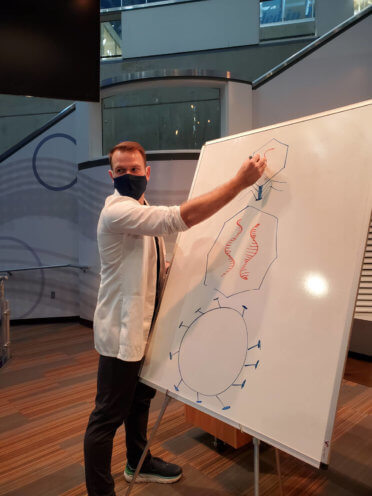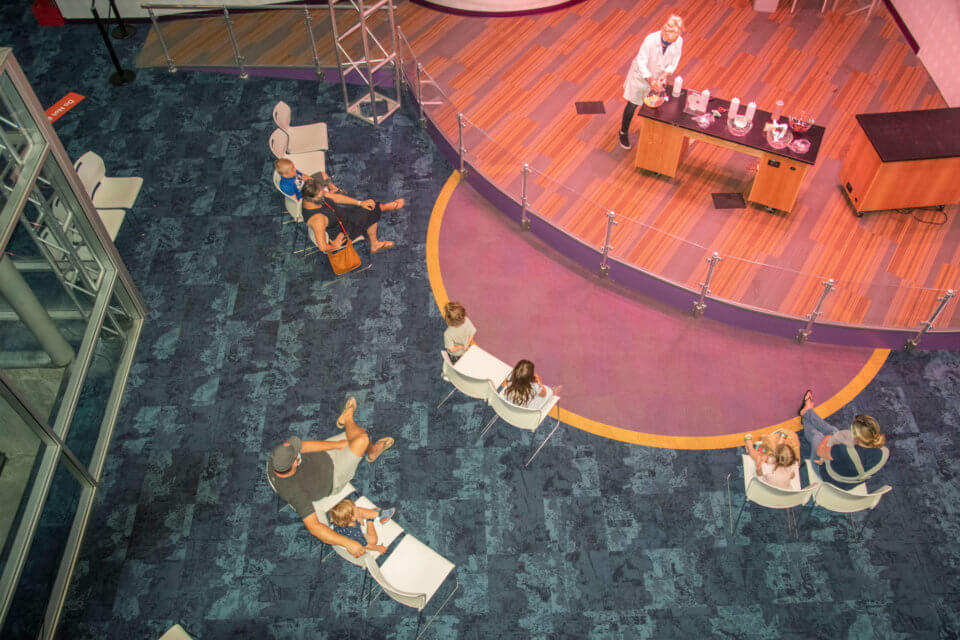If you had to pick one topic in science that’s on just about everyone’s mind right now, viruses are probably a safe bet. The global SARS-COV-2 pandemic has stretched into more than half of the year and, with no end in sight, remains an area of focus for scientists and doctors around the world. It’s something that John Nahon, Manager of Energy Stage and Earth Sciences at the Saint Louis Science Center, believes the community needs to know more about.
This summer, John developed GermBusters!, a live STEAM Performance for the Science Center’s Energy Stage. Energy Stage, the open performance space located at the heart of the Science Center’s Oakland Building, hosts a number of free shows each day on varied science topics. From Colder Than Ice to It’s A Blast, STEAM Performances make for some of the most visually (and sometimes audibly) impressive expressions of just how flashy science can be.
With GermBusters!, John and the team at Energy Stage are taking a slightly different tack.
A unique opportunity.
“This is sort of a unique opportunity in that we have this situation where the whole world is so deeply relating with and trying to understand viruses and the pandemic,” John says. “One of the ways in which we engage people is by making content [at Energy Stage] super relevant to their lives.”
John, who holds a degree in biochemistry from Washington University, says that viruses are something he’s personally interested in, so developing a show that touched on not just the broad topic of viruses but also their molecular biology was a perfect fit. It was a natural step, he says, to start cranking on a related stage show.

From Colder Than Ice to It’s A Blast, STEAM Performances make for some of the most visually (and sometimes audibly) impressive expressions of just how flashy science can be.
 So what does a show about viruses look like?
So what does a show about viruses look like?
For an approximately fifteen-minute performance, GermBusters! covers a lot. “We want [audiences] to learn that viruses are simple agents of replication that aren’t really alive,” John says. “We want them to learn that masks work kind of like spiderwebs and grab onto particles that pass through. We want them to learn exactly how things like soap and water and hand sanitizer work to kill viruses.”
Beyond that, the show gives audiences a better understanding of the protective measures that have been recommended repeatedly (and sometimes politicized) and why scientifically they work. “We really wanted [audiences] to wash their hands more often, so talking about how effective it is. ‘It works. Here’s the science behind it.’ And to wear masks effectively and choose materials that make effective masks.”
Injecting fun into lecture-based learning.
For GermBusters! John knew that the topic of viruses was so relevant to people that he would be able to incorporate more lecture-based learning versus some of their other performances. While Energy Stage shows always relate back to the underlying science of an experiment, it’s not unusual during a performance to catch a burst of flame or a bang! from the stage, followed by the delighted oohs and ahhs of the kids in the audience.

“We mimic a sneeze with flame bottles. We do elephant toothpaste and talk about how peroxides kill viruses. Then we do a whoosh bottle after talking about denatured alcohol and how it has ethanol in it, and ethanol is what’s used in hand sanitizer to kill viruses.”
During this show, John brings out a whiteboard to illustrate genetic material as well as what a protein is and how a virus self-assembles. “With viruses people are highly interested, and so we feel a bit more comfortable diving into some of that harder science.”
That’s not to say that those ooh moments aren’t there, however. John says, “We mimic a sneeze with flame bottles. We do elephant toothpaste and talk about how peroxides kill viruses. Then we do a whoosh bottle after talking about denatured alcohol and how it has ethanol in it, and ethanol is what’s used in hand sanitizer to kill viruses.” While the connection between the science of the demonstrations and the topic at hand might require a little creative bridging, ultimately John says, “We want people to feel that they’re still having a little bit of fun.”
Accessible to everyone.
Part of that desire to incorporate fun into the shows stems from the fact that Energy Stage’s STEAM Performances are open to everyone—from school-age kids and teens all the way up to adults and seniors. This poses a challenge: how in a live show do you cater to such varied audiences, still deliver engaging STEAM content, and do so in about as much time as it takes to order and pick up carryout?
“The way we try to do shows in general,” John says, “is to assume that nobody knows anything. So you start at your baseline.” From there, John and the stage’s other educators will ask questions to gauge how much that particular audience knows about the show’s topic. “So we get into our basics, and then as we get into the show we’ll get a bit more advanced, and at a certain place we’ll pop in some facts or questions that challenge people more on the higher end.”

“It’s harder now to use demonstrations in order to interact. We can’t get close to people. We can’t let them have some of those tactile sensory experiences because of the need to be six feet away.”
That approach allows each show to deliver something to its audience members. Those without a wealth of science knowledge still get a basic understanding and the possibility of catching some of the higher level concepts while also allowing those with a bit more science literacy to learn and be engaged as well.
Keeping shows engaging in the midst of a viral pandemic is something that’s on John’s mind. “It’s harder now to use demonstrations in order to interact,” he says. “We can’t get close to people. We can’t let them have some of those tactile sensory experiences because of the need to be six feet away.”
The Energy Stage team has been able to adjust some of the shows to this new world of social distancing and mask wearing. “We still strive to have that interactive experience with the audience, so it’s a lot of back and forth now verbally. I think we’ve become more verbally inquisitive with our audiences.”
An important topic.
Ultimately, with GermBusters! if there’s one thing John wants people to take away from the show it’s a feeling. “We wanted [audiences] to feel empowered,” he says, “to understand what a virus is and exactly how it affects their lives. We want to get them to the point where they feel accomplished enough to say, ‘Oh, okay, I know what a virus is, and I know what’s going on with it, and I have a little bit more understanding of what’s happening in the world around me.’ “
“We’re becoming more comfortable with saying, ‘Okay, there is more harder science in this [show], but that’s totally fine. Because it’s important information. It needs to be heard.”
GermBusters! can be seen daily at Energy Stage.
Your Support
Support from donors, Science Center members, and Supporting-level members is instrumental in helping the Science Center continue offering connections to science for everyone in our region. If you’d like to show additional support for our mission, please consider donating to the Science Center’s Annual Fund, becoming a member, or becoming a Supporting-level member.
Your Impact

Want to learn more about how the Science Center and its supporters are making a difference for STEAM learning in the St. Louis region?
Connect with curiosity!







